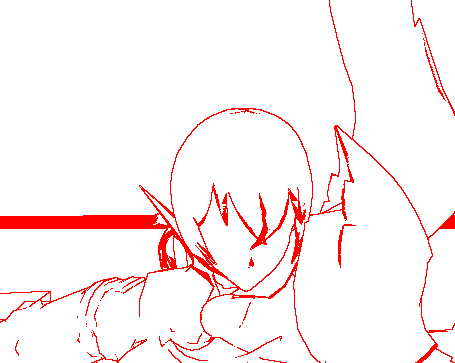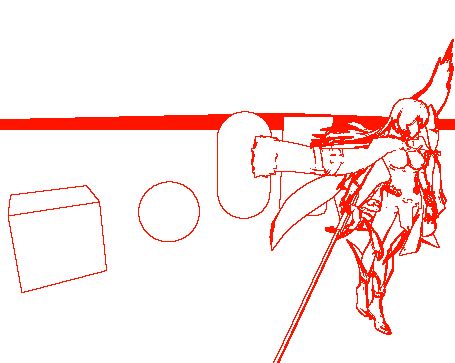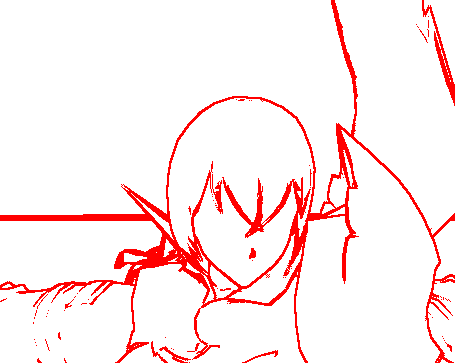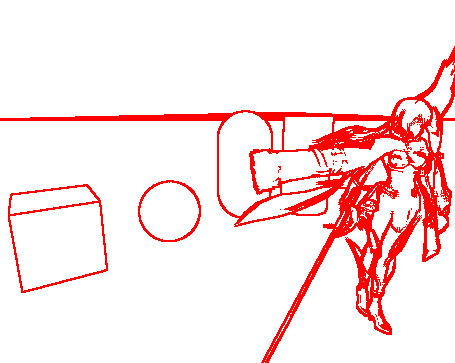最近事情太多,学习时间断断续续,终于挤出时间,将深度+法线边缘检测的基础学习完
前一篇:Unity Shader PostProcessing - 2 - 边缘检测,是基于图像像素来边缘检测的。
在平面像素边缘检测会遇到很多像素颜色问题导致检测不精准
那么在有几何体的情况下,后处理能否精准边缘检测呢?
肯定是可以的:后处理的深度、法线纹理图像缓存数据来边缘检测
提取深度、法线
首先,准备好脚本:
shader
- DepthNormalCOM.cginc
- RetrieveDepthNormal.shader
- RetrieveDepth.shader
- RetrieveDepth1.shader
- RetrieveNormal.shader
scripts
- TestRetrieveDepthNormalsTexture.cs
具体脚本如下:
Shader
- DepthNormalCOM.cginc
// DepthNormalCOM.cginc
// jave.lin 2019.08.29
// 获取Depth与Normal纹理
// Depth获取有两种方式
#include "UnityCG.cginc"
struct appdata {
float4 vertex : POSITION;
float2 uv : TEXCOORD0;
};
struct v2f {
float4 vertex : SV_POSITION;
float2 uv : TEXCOORD0;
};
// 下面vert_DN, frag_DN, frag_D, frag_D1, frag_N 是后处理测试内容中使用
// 对主相机的Depth与Normal的纹理的内容采样输出到屏幕中查看结果
sampler2D _CameraDepthNormalsTexture;
sampler2D _CameraDepthTexture;
v2f vert_DN (appdata v) {
v2f o;
o.vertex = UnityObjectToClipPos(v.vertex);
o.uv = v.uv;
return o;
}
fixed4 frag_DN (v2f i) : SV_Target { // main camera, depthMode = DepthNormals都可以
return tex2D(_CameraDepthNormalsTexture, i.uv); // 获取未解码的深度、法线纹理信息
}
fixed4 frag_D (v2f i) : SV_Target { // main camera, depthMode = DepthNormals都可以
return DecodeFloatRG ((tex2D(_CameraDepthNormalsTexture, i.uv)).zw); // 获取解码后的[0~1]的线性深度信息
}
fixed4 frag_D1 (v2f i) : SV_Target { // main camera, depthMode = Depth或DepthNormals都可以
return Linear01Depth (SAMPLE_DEPTH_TEXTURE(_CameraDepthTexture, i.uv)); // 另一种方式来获取[0~1]的线性深度信息
}
fixed4 frag_N (v2f i) : SV_Target { // main camera, depthMode = DepthNormals都可以
fixed4 dn = tex2D(_CameraDepthNormalsTexture, i.uv);
return fixed4(DecodeViewNormalStereo(dn),1) * 0.5 + 0.5; // 获取解码后的[0~1]的法线信息,没有n*0.5+0.5就是:[-1~1]的法线信息
}
- RetrieveDepthNormal.shader
// RetrieveDepthNormal.shader
// jave.lin 2019.08.31
Shader "Test/RetrieveNormal" {
CGINCLUDE
#include "DepthNormalCOM.cginc"
ENDCG
SubShader {
Pass {
ZTest Always ZWrite Off Cull Off
CGPROGRAM
#pragma vertex vert_DN
#pragma fragment frag_N
ENDCG
}
}
Fallback "Diffuse"
}
- RetrieveDepth.shader
// RetrieveDepth.shader
// jave.lin 2019.08.31
Shader "Test/RetrieveDepth" {
CGINCLUDE
#include "DepthNormalCOM.cginc"
ENDCG
SubShader {
Pass {
ZTest Always ZWrite Off Cull Off
CGPROGRAM
#pragma vertex vert_DN
#pragma fragment frag_D
ENDCG
}
}
Fallback "Diffuse"
}
- RetrieveDepth1.shader
// RetrieveDepth1.shader
// jave.lin 2019.08.31
Shader "Test/RetrieveDepth1" {
CGINCLUDE
#include "DepthNormalCOM.cginc"
ENDCG
SubShader {
Pass {
ZTest Always ZWrite Off Cull Off
CGPROGRAM
#pragma vertex vert_DN
#pragma fragment frag_D1
ENDCG
}
}
Fallback "Diffuse"
}
- RetrieveNormal.shader
// RetrieveNormal.shader
// jave.lin 2019.08.31
Shader "Test/RetrieveNormal" {
CGINCLUDE
#include "DepthNormalCOM.cginc"
ENDCG
SubShader {
Pass {
ZTest Always ZWrite Off Cull Off
CGPROGRAM
#pragma vertex vert_DN
#pragma fragment frag_N
ENDCG
}
}
Fallback "Diffuse"
}
Scripts
// jave.lin 2019.08.31
// 测试后处理中提取深度、法线
using UnityEngine;
public class TestRetrieveDepthNormalsTexture : MonoBehaviour
{
public Shader retrieveDepthNormalShader;
public Shader retrieveDepthShader;
public Shader retrieveDepth1Shader;
public Shader retrieveNormalShader;
// 公开给外部Inspector中双击RT可查看内容
public RenderTexture depthAndNormalRT;
public RenderTexture depthRT;
public RenderTexture depth1RT;
public RenderTexture normalRT;
private Material DN_Mat;
private Material D_Mat;
private Material D1_Mat;
private Material N_Mat;
void Start()
{
DN_Mat = new Material(retrieveDepthNormalShader);
D_Mat = new Material(retrieveDepthShader);
D1_Mat = new Material(retrieveDepth1Shader);
N_Mat = new Material(retrieveNormalShader);
depthAndNormalRT = RenderTexture.GetTemporary(Screen.width, Screen.height);
depthRT = RenderTexture.GetTemporary(Screen.width, Screen.height);
depth1RT = RenderTexture.GetTemporary(Screen.width, Screen.height);
normalRT = RenderTexture.GetTemporary(Screen.width, Screen.height);
// Depth==>_CameraDepthTexture
// DepthNormals ==>_CameraDepthNormalsTexture
GetComponent<Camera>().depthTextureMode |= DepthTextureMode.DepthNormals;
}
private void OnRenderImage(RenderTexture source, RenderTexture destination)
{
Graphics.Blit(source, depthAndNormalRT, DN_Mat); // 使用_CameraDepthNormalsTexture来提取深度、法线数据
Graphics.Blit(source, depthRT, D_Mat); // 使用_CameraDepthNormalsTexture来提取深度数据
Graphics.Blit(source, depth1RT, D_Mat); // 使用_CameraDepthTexture来提取深度数据
Graphics.Blit(source, normalRT, N_Mat); // 使用_CameraDepthNormalsTexture来提取法线数据
Graphics.Blit(source, destination, DN_Mat); // 将_CameraDepthNormalsTexture纹理数据直接输出到屏幕查看结果
}
}
Scene
场景简单放置一些几何网格渲染对象
然后将cs脚本挂载在主相机(Main Camera)中,在给cs脚本对应的脚本中的shader变量设置好后
运行结果如下:
后处理前

后处理
_CameraDepthNormalsTexture中的深度+法线信息

_CameraDepthTexture或_CameraDepthNormalsTexture中的深度信息

_CameraDepthNormalsTexture中的法线*0.5+0.5信息

注意:需要在Shader在使用_CameraDepthTexture或是_CameraDepthNormalsTexture纹理的内容。
需要对主相机(Main Camera)的depthModde设置为:Depth或是DepthNormals。
然后Unity会在所有用户自定义的shader的渲染对象渲染前,先提取所有shader tag 中有"Queue"="Geometry"对象渲染到_CameraDepthTexture或是_CameraDepthNormalsTexture纹理缓存中。
再传入到后面用户自定义的shader中,以供使用。
有了屏幕的深度和法线信息,那么我就在后处理使用它们来描边了
描边
部分代码参考了《Unity Shader入门精要》
如下这我修改后的效果
仅距离的边缘还不错

远距离的边缘显得太粗

Shader1
// jave.lin 2019.9.1
// 使用深度+法线的边缘检测后处理使用
Shader "Test/DepthNormalEdgeDetect" {
Properties {
_MainTex ("Texture", 2D) = "white" {}
_DepthEdgeThreshold ("DepthEdgeThredshold", Range(0,0.001)) = 0.0001 // 大于该阈值算是深度边缘
_NormalEdgeThreshold ("NormalEdgeThredshold", Range(0,1)) = 0.95 // 小于该阈值算是法线边缘
_EdgeIntensity ("EdgeIntensity", Range(0,1)) = 1 // 边缘颜色强度
_EdgeOnlyIntensity ("EdgeOnlyIntensity", Range(0,1)) = 0 // 显示_EdgeBgColor,仅突出边缘的强度
_EdgeColor ("EdgeColor", Color) = (0,0,0,1) // 边缘的颜色
_EdgeBgColor ("EdgeBgColor", Color) = (1,1,1,1) // 边缘颜以外的颜色,使用_EdgeOnlyIntensity来控制强弱
}
SubShader {
ZTest Always ZWrite Off Cull Off
Pass {
CGPROGRAM
#pragma vertex vert
#pragma fragment frag
#include "UnityCG.cginc"
struct appdata {
float4 vertex : POSITION;
float2 uv : TEXCOORD0;
};
struct v2f {
float4 vertex : SV_POSITION;
float2 uv : TEXCOORD0;
};
sampler2D _MainTex;
float4 _MainTex_TexelSize;
sampler2D _CameraDepthNormalsTexture;
float _DepthEdgeThreshold;
float _NormalEdgeThreshold;
fixed _EdgeIntensity;
fixed _EdgeOnlyIntensity;
fixed4 _EdgeColor;
fixed4 _EdgeBgColor;
v2f vert (appdata v) {
v2f o;
o.vertex = UnityObjectToClipPos(v.vertex);
o.uv = v.uv;
return o;
}
inline float Get_G(half4 data1, half4 data2) {
float d1 = DecodeFloatRG (data1.zw); // 解码深度
float3 n1 = DecodeViewNormalStereo(data1); // 解码法线
float d2 = DecodeFloatRG (data2.zw);
float3 n2 = DecodeViewNormalStereo(data2);
return step(_DepthEdgeThreshold, abs(d1 - d2) * 0.01) + step(dot(n1, n2), _NormalEdgeThreshold);
}
fixed IsEdge(float2 uv) {
// 借用Roberts边缘算法思想(大多资料喜欢叫:算子,之前跑去图书馆看了OpenCV也叫:算子)
// Gx = |-1| 0|
// | 0| 1|
//
// Gy = | 0|-1|
// | 1| 0|
// final g = |Gx| + |Gy| // 下面就没必要abs运算了,因为step return 0、1
// 这里的uv运算量没必要写在vs,因为值有一个‘+’操作
// 如果写在vs,除了占用vs寄存器
// 计算量也不少,反而会增加运算量,因为每个片段透视插值需要:
// 具体可了解我之前写的:C# 实现精简版的栅格化渲染器:https://blog.csdn.net/linjf520/article/details/99129344
// - 运算 invCamZ = 1 / cameraZ // 这个可以不算,因为其他顶点数据透视插值也是需要的,那么以下三项都算
// - 乘以 invCamZ
// - lerp(srcFrag, toFrag, t) // 两个乘以,一个加
// - 乘以 CamZ
half4 gx_top_left = tex2D(_CameraDepthNormalsTexture, uv + fixed2(0, _MainTex_TexelSize.y));
half4 gx_bottom_right = tex2D(_CameraDepthNormalsTexture, uv + fixed2(_MainTex_TexelSize.x, 0 ));
half4 gy_top_right = tex2D(_CameraDepthNormalsTexture, uv + fixed2(_MainTex_TexelSize.x, _MainTex_TexelSize.y));
half4 gy_bottom_left = tex2D(_CameraDepthNormalsTexture, uv);
fixed gx = Get_G(gx_bottom_right, gx_top_left);
fixed gy = Get_G(gy_bottom_left, gy_top_right);
return saturate(gx + gy);
}
fixed4 frag (v2f i) : SV_Target {
fixed4 srcCol = tex2D(_MainTex, i.uv);
srcCol = lerp(srcCol, _EdgeBgColor, _EdgeOnlyIntensity);
fixed4 edgeCol = lerp(srcCol, _EdgeColor, _EdgeIntensity);
return lerp(srcCol, edgeCol, IsEdge(i.uv));
}
ENDCG
}
}
}
Script1 后处理脚本
// jave.lin 2019.08.29
// 使用深度、法线来边缘检测的后处理
using UnityEngine;
public class EdgeDetectByDepthNormal : PostEffectBasic
{
private static int DepthEdgeThredshold_hash = Shader.PropertyToID("_DepthEdgeThreshold");
private static int NormalEdgeThredshold_hash = Shader.PropertyToID("_NormalEdgeThreshold");
private static int EdgeIntensity_hash = Shader.PropertyToID("_EdgeIntensity");
private static int EdgeOnlyIntensity_hash = Shader.PropertyToID("_EdgeOnlyIntensity");
private static int EdgeColor_hash = Shader.PropertyToID("_EdgeColor");
private static int EdgeBgColor_hash = Shader.PropertyToID("_EdgeBgColor");
[Range(0, 0.001f)] public float DepthEdgeThredshold = 0.0001f;
[Range(0, 1)] public float NormalEdgeThredshold = 0.95f;
[Range(0, 1)] public float EdgeIntensity = 1;
[Range(0, 1)] public float EdgeOnlyIntensity = 0;
[ColorUsage(false)] public Color EdgeColor = Color.red;
[ColorUsage(false)] public Color EdgeBgColor = Color.white;
protected override void Start()
{
base.Start();
Camera.main.depthTextureMode |= DepthTextureMode.DepthNormals;
}
protected override void OnRenderImage(RenderTexture source, RenderTexture destination)
{
if (!IsSupported) { Graphics.Blit(source, destination); return; } // 不支持
mat.SetFloat(DepthEdgeThredshold_hash, DepthEdgeThredshold);
mat.SetFloat(NormalEdgeThredshold_hash, NormalEdgeThredshold);
mat.SetFloat(EdgeIntensity_hash, EdgeIntensity);
mat.SetFloat(EdgeOnlyIntensity_hash, EdgeOnlyIntensity);
mat.SetColor(EdgeColor_hash, EdgeColor);
mat.SetColor(EdgeBgColor_hash, EdgeBgColor);
Graphics.Blit(source, destination, mat);
}
}
下面是《Unity Shader入门精要》中的效果


相比上面我修改后的效果来说,边缘更粗了
Shader2
// jave.lin 2019.09.02
// 参考:《Unity Shader入门精要》 - 13.4
Shader "Test/EdgeDetectNormalsAndDepth" {
Properties {
_MainTex ("Texture", 2D) = "white" {}
_EdgeOnly ("Edge Only", Float) = 1.0
_EdgeColor ("Edge Color", Color) = (0, 0, 0, 1)
_BackgroundColor ("Background Color", Color) = (1, 1, 1, 1)
_SampleDistance ("Sample Distnce", Float) = 1.0
_Sensitivity ("Sensitivity", Vector) = (1, 1, 1, 1)
}
CGINCLUDE
#include "UnityCG.cginc"
sampler2D _MainTex;
half4 _MainTex_TexelSize;
fixed _EdgeOnly;
fixed4 _EdgeColor;
fixed4 _BackgroundColor;
float _SampleDistance;
half4 _Sensitivity;
sampler2D _CameraDepthNormalsTexture;
struct v2f {
float4 pos : SV_POSITION;
half2 uv[5] : TEXCOORD0;
};
half CheckSame(half4 center, half4 sample) {
half2 centerNormal = center.xy;
float centerDepth = DecodeFloatRG(center.zw);
half2 sampleNormal = sample.xy;
float sampleDepth = DecodeFloatRG(sample.zw);
// difference in normals
// do not bother decoding normals - there's no need here
half2 diffNormal = abs(centerNormal - sampleNormal) * _Sensitivity.x;
int isSameNormal = (diffNormal.x + diffNormal.y) < 0.1;
// difference in depth
float diffDepth = abs(centerDepth - sampleDepth) * _Sensitivity.y;
// scale the required thredshold by the distance
int isSameDepth = diffDepth < 0.1 * centerDepth;
// return :
// 1 - if normals and depth are similar enough
// 0 - otherwise
return isSameNormal * isSameDepth ? 1.0 : 0.0;
}
v2f vert(appdata_img v) {
v2f o;
o.pos = UnityObjectToClipPos(v.vertex);
half2 uv = v.texcoord;
o.uv[0] = uv;
#if UNITY_UV_STARTS_AT_TOP
if (_MainTex_TexelSize.y < 0)
uv.y = 1 - uv.y;
#endif
o.uv[1] = uv + _MainTex_TexelSize.xy * half2(1,1) * _SampleDistance;
o.uv[2] = uv + _MainTex_TexelSize.xy * half2(-1,-1) * _SampleDistance;
o.uv[3] = uv + _MainTex_TexelSize.xy * half2(-1,1) * _SampleDistance;
o.uv[4] = uv + _MainTex_TexelSize.xy * half2(1,-1) * _SampleDistance;
return o;
}
fixed4 fragRobertsCrossDepthAndNormal(v2f i) : SV_Target {
half4 sample1 = tex2D(_CameraDepthNormalsTexture, i.uv[1]);
half4 sample2 = tex2D(_CameraDepthNormalsTexture, i.uv[2]);
half4 sample3 = tex2D(_CameraDepthNormalsTexture, i.uv[3]);
half4 sample4 = tex2D(_CameraDepthNormalsTexture, i.uv[4]);
half edge = 1.0;
edge *= CheckSame(sample1, sample2);
edge *= CheckSame(sample3, sample4);
fixed4 withEdgeColor = lerp(_EdgeColor, tex2D(_MainTex, i.uv[0]), edge);
fixed4 onlyEdgeColor = lerp(_EdgeColor, _BackgroundColor, edge);
return lerp(withEdgeColor, onlyEdgeColor, _EdgeOnly);
}
ENDCG
SubShader {
Tags { "RenderType"="Opaque" }
Pass {
ZTest Always Cull Off ZWrite Off
CGPROGRAM
#pragma vertex vert
#pragma fragment fragRobertsCrossDepthAndNormal
ENDCG
}
}
}
Script2 后处理脚本
using UnityEngine;
public class EdgeDetectNormalsAndDepth : PostEffectBasic
{
[Range(0.0f, 1.0f)]
public float edgesOnly = 0.0f;
public Color edgeColor = Color.black;
public Color backgroundColor = Color.white;
public float sampleDistance = 1.0f;
public float sensitivityDepth = 1.0f;
public float sensitivityNormals = 1.0f;
private void OnEnable()
{
GetComponent<Camera>().depthTextureMode |= DepthTextureMode.DepthNormals;
}
protected override void OnRenderImage(RenderTexture source, RenderTexture destination)
{
if (!IsSupported) { Graphics.Blit(source, destination); return; }
mat.SetFloat("_EdgeOnly", edgesOnly);
mat.SetColor("_EdgeColor", edgeColor);
mat.SetColor("_BackgroundColor", backgroundColor);
mat.SetFloat("_SampleDistance", sampleDistance);
mat.SetVector("_Sensitivity", new Vector4(sensitivityNormals, sensitivityDepth, 0.0f, 0.0f));
Graphics.Blit(source, destination, mat);
}
}
Project
TestEdgeByDepthAndNormal_边缘检测基于深度+法线.zip
总结
目前没有发现比较好的边缘效果,各有优缺点
- 基于后效图像的颜色亮度(灰度),会有受颜色影响边缘精度,粗细度也不好控制,一般场景几何体绘制比较多,都会用这种方式,剩下一些Drawcall。
- 基于后效提取几何体的深度、法线缓存纹理的差异,边缘粗细度不好控制,特别是远距离边缘太粗;
- 基于单个Shader中pass对几何体背面挤出绘制,边缘效果最好,还可以控制粗细,但几何体法线相对相机角度的梯度太大,会导致描边效果不理想,如:正方体:Cube,在角的部分的描边不理想。但也会对Drawcall翻倍。
希望能有人分享边缘其他的检测方式,可以完美处理上述为题的方案,目前我还没找到。
References
- 《Unity Shader入门精要》 - 13.4

























 7939
7939











 被折叠的 条评论
为什么被折叠?
被折叠的 条评论
为什么被折叠?








